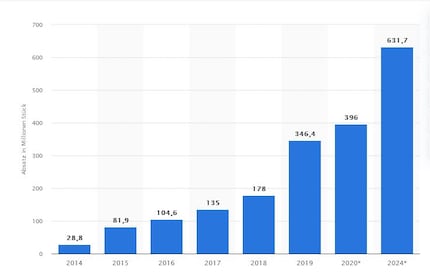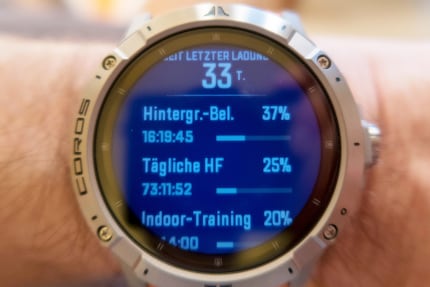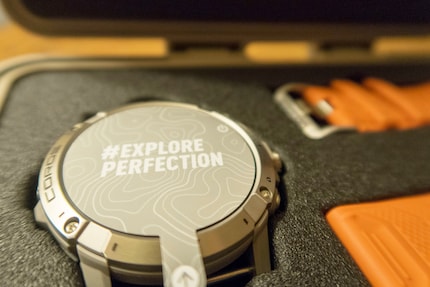
Background information
Project Half Marathon: fitness test causes cramp
by Oliver Fischer

Wearables are – you guessed it – wearable technologies that are finding their way into our everyday lives. Nifty watches or wristbands count our steps, measure our blood oxygen levels or do medical ECGs. But how accurate are the measurements? What happens to the data? And will all and sundry soon be wearing one of these gadgets on their wrists?
«Wearables» is the umbrella term for electronic devices that can be worn on the body – and they’re as trendy as ever. According to a forecast from September 2020, 630 million smartwatches and fitness bands will be in use worldwide by the year 2024. And the numbers are rising.

One of those grappling with wearable tech on a scientific level is Silvio Lorenzetti from the Swiss Federal Office of Sport. Having studied physics and mathematics, he now leads the department of competitive sports at the Swiss Federal Institute of Sport in Magglingen and is in charge of a National Fund project, among other things. The fund’s goal is to develop an app that can determine the volume of exercise during strength training and ultimately predict the body’s adaptation to these levels of strain.

Silvio Lorenzetti, it strikes me that wearables, regardless of their manufacturer, focus on endurance sports, especially running. Why is that the case?
Dr Silvio Lorenzetti: That’s a good question – and a justified one at that. Running can easily be measured with GPS and accelerometers. With that, you get the running distance, number of steps, speed or even the number of metres in altitude covered. This makes it relatively easy to record and describe athletic performance. It’s definitely the main reason why so much of the focus is on running. And the fact that lots of people run.
As we age, the focus shifts from endurance sports to strength training. Shouldn’t manufacturers take this into account and adapt their technology accordingly?
You’re partly right. In general, we recommend that everyone over the age of 18 do strength training at least twice a week in addition to cardio training. That’s the recommendation of the WHO, by the way.
Exactly. And, in my opinion, this fact is ignored by wearables manufacturers – whether it’s Garmin, Polar or Coros.
Yes, I agree with you there. Looking at it from a scientific point of view, the industry isn’t ideally positioned in this area. Years ago, however, there were companies who specialised in weight training – Push being one example. They developed a Wearable that focused on strength training a while back. But this sector has changed a bit in recent years.
In what way?
Many people who do performance-oriented weight training do velocity-based strength training. On top of this, people tend to do it indoors. Being inside means there are relatively simple ways to record precise data, say via a pulley sensor. So, on the one hand, with the GPS you have a good product for running outdoors, and on the other hand, it’s easier to use other types of measuring devices when doing indoor strength training. It’s also difficult to make conclusive judgements about strength training with the common sensors built into watches.

The key phrase is data quality – a frequently discussed topic when it comes to wearables. What about this? How accurate are the measurements in general?
Here, it very much depends on the data you’re looking at. Wearables generally have acceleration sensors, angular velocity sensors and, in some cases, GPS built into them. Because of their functionality, the first two sensors are limited when it comes to pinpointing the position of the watch or accurately determining what distance has been covered. The actual acceleration figures, on the other hand, are very accurate.
Can you expand on that please?
The general conclusion is that the sensors mostly take accurate measurements. Interpreting the data, on the other hand, is pretty difficult. The fusion of separate sensors can increase the quality of the data.
I’ve been spending my summer holidays in Engadin. My Coros Vertix 2 has an altimeter, but its readings rarely corresponded to my actual altitude.
The altimeter is strongly impacted by the weather and you need to calibrate it regularly to get reliable data. If you calibrate it when you’re in a valley and there are no major weather changes on your way to the mountain, the altimeter will probably work quite well.
My watch also tells me how many calories I consume per day. How’s that in terms of accuracy?
In this case, your basal metabolic rate needs to be determined first, followed by how many calories you burn through physical exercise. So, all in all, these figures should be taken with a pinch of salt.
The Apple Watch even creates a medical electrocardiogram or ECG. How reliable do you reckon that is?
The Apple Watch has been approved by the FDA, the US Food and Drug Administration. So, I think it’s safe to assume that the figures are quite consistent. Basically, the same question comes up time and again: what are these figures used for and how are they interpreted?

As your Average Joe consumer, I quickly get overwhelmed by the stream of data and the process of interpreting it correctly. But what do top athletes, coaches or you as a researcher get from it?
Let’s take the scientific perspective first. In the past, sports science was limited to performance testing under laboratory conditions. The data collected in this way was very precise and useful. However, the figures were dependent on a number of factors, such as how the athletes were feeling on a given day. The variability of the athletes was higher than that of the measuring devices.
And now?
There’s been a kind of democratisation of measuring devices. Wearables are available today at relatively cheap prices, the data they collect is freely available and you can analyse it. A large proportion of athletes take advantage of the opportunities the technology offers them. Our job as scientists is now to assess the quality of that data. To judge which figures are accurate and which ones should be interpreted with caution. And to reconcile these values with lab tests, which we’re obviously still carrying out. The combination of lab data and the data from the wearables provides a good overview of an athlete’s fitness.
What benefit does a trainer derive from this stream of data?
That’s difficult to say, actually. Trainers are confronted with a tsunami of information. In this case, it’s important to always keep the quality of the data in mind. There’s no point in obsessing over a figure that’s changed because it was measured inaccurately. And it’s crucial to understand which parameters are actually relevant for the athletes.
Let’s talk more about data security. This is also a much-discussed issue.
That’s an important point. First and foremost, everyone should be aware of what kind of data is being disclosed when they’re using a wearable. And athletes should think carefully about who they’re sharing data with and for what purpose. The data should also always be uploaded to the cloud anonymously using an ID, not with the athlete’s name. Otherwise, as is obviously the case on the internet in general, you run the risk of data being stolen or misappropriated.
Are athletes today already losing their privacy because of wearables?
You’re touching on a huge issue here that will have to be widely discussed by us as a society. Which data set determines an athlete’s worth, for example. For instance, let’s take a footballer’s health data. The club that might want to buy this player would certainly be keen to know if they’d torn their cruciate ligament. It’s also in sports organisations’ interest to ensure that their athletes are healthy. The importance of data use agreements between the individual parties will increase enormously in the future.
And what does the future of wearable tech look like? Today, we’re talking about smartwatches, fitness wristbands, heart rate belts and earwear. When will we get a silver bullet, that one gizmo that can do everything?
I think that’s still in the early stages of development. There’s still a long way to go. Wearables are still a fairly young technology that’ll continue to develop rapidly over the next few years. Today, there are already companies producing, for example, patches that analyse the composition of sweat or determine the surface temperature of the skin. That said, I doubt there’ll ever be a device that can do everything. I think we’ll have different sensors, worn in different places on the body, performing different functions. The sensors of the future, however, will work together in tandem. The ability to synchronise different systems from different manufacturers and merge the data sources is still lacking today.
From radio journalist to product tester and storyteller, jogger to gravel bike novice and fitness enthusiast with barbells and dumbbells. I'm excited to see where the journey'll take me next.
Interesting facts about products, behind-the-scenes looks at manufacturers and deep-dives on interesting people.
Show all